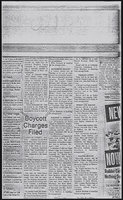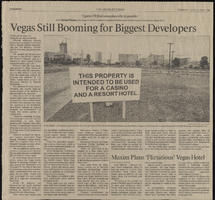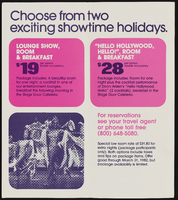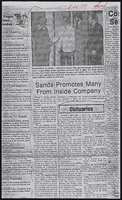Search the Special Collections and Archives Portal
Search Results
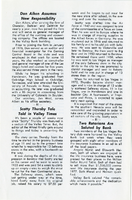
The Wheel Las Vegas Rotary Club newsletter, late 1970s
Date
Archival Collection
Description
Text
Kent Carmichael oral history interview
Identifier
Abstract
Oral history interview with Kent Carmichael conducted by Stefani Evans on November 25 and December 2, 2019 for the Boyer Early Las Vegas Oral History Project.
In the first session of this oral history, Carmichael discusses his early career in lighting design and maintenance from his start at Interstate Neon to his work in the 1950s and 60s in Las Vegas. He discusses some of the iconic signs he built including the Casino Center, Carnival Room, Thunderbird, The Frontier, Bonanza, and the Stardust. He also details the technology and inner workings of these innovative signs including the transition from mechanical to electrically controlled signage. Carmichael continues to discuss Native American laborers and various individuals that he interacted with throughout his early career including Max and Mo Oggenblick, Doby Doc, Benny Binion, Arby Alper, Steve Wynn, Peter Arp, and Wayne and Jerry Newton. Carmichael ends the first interview by recalling a high wind event that damaged the Frontier sign and his efforts to bring the sign under control and repair it as well as his vision and behind the Stardust sign.
The second oral history interview contains Carmichael’s discussion of his career from 1968 onward. He immediately picks up discussion of the Stardust sign and his transition to desk work. Carmichael details the challenge and limitations of designing the International sign (the Westgate as of 2021). He describes the development of his first messenger sign for the International and the time consuming task of using tape to program the sign. He fondly remembers working on the Holiday Inn Riverboat signs, and International transition to Las Vegas Hilton and the Hilton’s transition from blue to red letters. Carmichael shares the story of being caught between organized crime and a young Steve Wynn. He recounts his last project for Ad Art, developing and construction the sign for the Louisiana Superdome in New Orleans, Louisiana. He details working through legislative and construction issues as well as the fallout from the Nat Kiefer Commission.
After leaving Ad Art Carmichael began working with Heath and Co. and began collaborating with Raul Rodriguez. Carmichael and Rodriguez went on to design some of the most enduring and visually unique signs in Las Vegas including, the Flamingo, Four Queens, Golden Nugget, Dunes Hotel, and the Desert Inn. They also worked in Reno on Circus Circus and El Dorado. Carmichael also details his interior work including the main pylon and interior signs for MGM Grand; 1974 renovation Golden Nugget, suspended stained glass ceiling at Tropicana, and the MGM Lion display. Lastly Carmichael outlined his work with Young Electric Sign 1983-85 and the Dewey Sign Company including the Las Vegas Convention Center sign. He ends by sharing his views on the role and importance of lighting in Las Vegas.
Archival Collection

Transcript of interview with Saul Wesley by David G. Schwartz, January 13, 2017
Date
Archival Collection
Description
Text
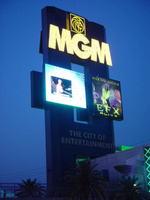
neo000049-002
Date
Description
Notes: The series of text in the left and right of the east face of the building which reads "Nightly Strip Rides" and "Grand Canyon Tours" are filled with incandescent bulbs which oscillate rapidly. The incandescent bulbs, which line the raceways, also chase each other. The main text which reads "Las Vegas Helicopter Tours" is also filled with incandescent bulbs which animate as well. The words "Las Vegas," star dark, then flash on and oscillate. Next, the word "Helicopters," illuminates one letter at a time in a rapid pace. The bulbs also oscillate once lit. The entire phrase shuts off simultaneously before starting over again. The word "Helicopters" remains dark until the first portion of the phrase illuminates. The American flag centerpiece animates as well. The incandescent bulbs placed in the center of each one of the stars oscillate rapidly resulting in a twinkling effect. The stars are constantly animated while the bars of neon slow chasing pattern. The field remains dark then all the horizontal bars illuminate all at once. They then chase upward, leaving all the illuminated tubes blank in it's path. Once it reaches the top then it chases downward illuminating all of the bars again. Once they are full, they all shut off and the sequence starts over again.

